by Marcus Soares and Stephan Kesting
Originally published in Grappling Magazine
Scroll down the page to go directly to one of Marcus’s ‘easier’ bodyweight conditioning routines
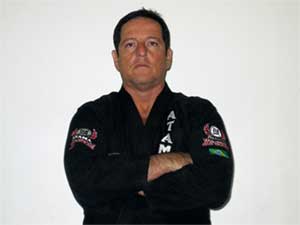
Marcus Soares, 7th degree Black Belt under the legendary Carlson Gracie, is a coach hunting for gold medals. He has been very successful in this goal: his fighters have won NHB matches in the United States, Canada, Japan, Korea and Russia. His jiu-jitsu students have also won medals in many important grappling tournaments, including the Jiu-jitsu World Championships, Jiu-jitsu World Cup, Grappler’s Quest, Pan-Ams, the Canadian and American Abu Dhabi Trials and many other tournaments.
He credits the success of his team to two primary factors: firstly the techniques that were taught to him by Carlson Gracie, and secondly the level of conditioning of his fighters. Marcus believes that conditioning is very important for all kinds of fighters. No matter how technical a fighter is, if he doesn’t win his match in the first few minutes then he needs the endurance to keep on trying to submit or defeat his opponent.
The Class ‘Warm-up’
If you have ever trained with Marcus Soares you will certainly remember the conditioning portion of class: a series of calisthenics and bodyweight exercises that leave even the best conditioned athletes soaking with sweat and gasping for breath. He usually devotes 25 or 30 minutes per class to conditioning.
Marcus used his university degree in physical education degree to develop this exercise routine. The exact sequence changes from day to day, and there are many variations and different exercises to keep the workout fresh. He makes sure that every workout challenges every part of the body.
The workout included in this article is simply to give you a taste of a relatively easy conditioning routine. No specialized equipment is required. If you find this routine too hard then you might want to do fewer repetitions of each exercise. If you find it too easy you could come and visit Marcus’s class to get a taste of the full workout.
Additional Training
Marcus believes that a dedicated competitor should do additional cardio; the class warm-up, although very tough, is not enough. Both aerobic and anaerobic training should be included.
For cardio training Marcus thinks that running is good and that running hills, in particular, is very good. When he was training in Rio, Brazil, Marcus used to run a two routes called Vista Chinesa and Mesa do Imperador. These paths are very steep, continuous and difficult. Locals say that if you can get to the top of Mesa do Imperador in under 30 minutes you are in good shape.
Marcus Soares
Weight training for jiu-jitsu and NHB fighters is also very important. Almost all Olympic athletes lift weights, even if they need to have very relaxed muscles. Swimmers, high divers, cyclists, runners, and ping-pong players all do weight training, so of course fighters have to weight train too. Don’t keep on weight training until right before the competition though: Marcus’s opinion is that fighters should stop lifting weights one month before a competition in order to allow the muscles to relax.
The primary goal of weight training for jiu-jitsu is to develop muscular endurance – you are not training to be a weight lifter or body builder. The way to develop endurance lifting weights is to do complexes or circuits using the same weight for many different exercises back to back. For example you might do 8 high pulls, 8 presses, 8 squats and 8 deadlifts in a row, take a short break and then repeat the circuit.
Building strength is also important, but strength training should be mainly be done when you are far away from a competition. Marcus prefers the basic exercises for each body part, for example pull-ups for the back, curls for the biceps, military presses for the shoulders and squats for the legs. Squats are particularly important because they not only work your legs (which are responsible for maintaining your base), but also because of the way they make your heart rate go up.
In addition to weight training and running there are other, more specialized, forms of training. For example, in Brazilian Jiu-jitsu the grip is very important. The most realistic training you can do for the gripping muscles is to do pull-ups hanging from your gi. Once you get good at this exercise you will have new confidence in your chokes, knowing that your grip isn’t going to slip down his collar as you hold the choke in place.
People have to consider their limits when figuring out how hard, and how often, to train. Some important factors determining a person’s physical limits include genetics, rest, nutrition, and whether they are working or doing another activity. Professional fighters may be able to do nothing other than train, eat and sleep, but most people have regular jobs, families, etc. and therefore they can’t train as hard as full-time athletes.
Marcus’s Conditioning History.
When Marcus was training in Brazil he used to do his conditioning by himself. At the time most clubs didn’t have a formal warm-up: you just stretched a little bit and then started to roll. Part of his inspiration to do more conditioning than everyone else came from observing several water polo players training at Carlson Gracie’s school: he noticed that these athletes were so fit that they would still be going hard after one hour of sparring. Soon thereafter Marcus started rowing, running hills, and even played some water polo.
An important influence on Marcus’s life in sport was his uncle, Herman Portes Gerber. Herman was a black belt in both judo and jiu-jitsu, was very intelligent, and was a professional soccer player. Marcus started weight training and conditioning in 1968 with his uncle’s encouragement and guidance, and he soon noticed how it improved his jiu-jitsu.
To understand what a revolutionary concept conditioning was, consider that the Brazilian soccer team only started doing extra conditioning in 1970. The Soccer team did this because they were preparing to compete in the soccer world cup at high altitude in Mexico. It was only after this time that most people started talking about conditioning and training methodologies.
Beginner’s Warmup
The 9 exercises are done one after another, without any rest. We want to emphasize that this is only a sample workout to give you the idea of how an ‘easy’ workout might be structured. Every warmup that Marcus leads is different, so after trying it once feel free to modify or add exercises and sequences, or change the number of repetitions.
Exercise 1: Jumping Jacks
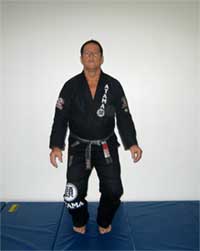 Warm up with basic jumping jacks for 3 minutes |
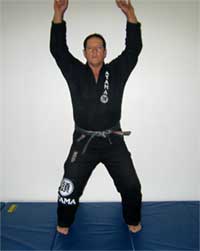 |
Exercise 2: Jump and Pushup
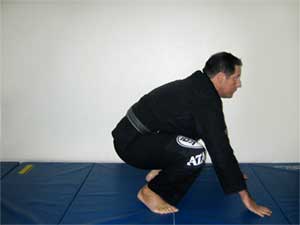 A - Start in a squat position with both hands on the floor |
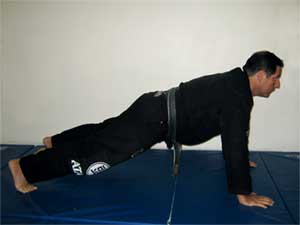 B - Jump back with both feet |
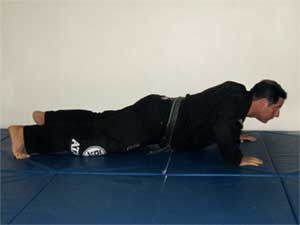 C - Lower yourself down into a pushup position |
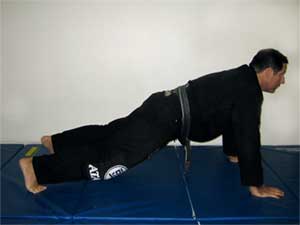 D - Push back up, maintaining good form |
 E - Jump both feet forward, and then repeat the whole exercise. Do 50 repetitions of this four-count exercise |
Exercise 3: Chinese Pushups
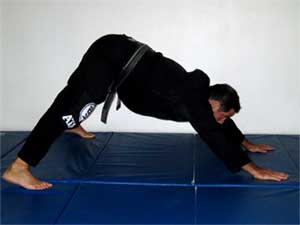 A - Start in a piked position |
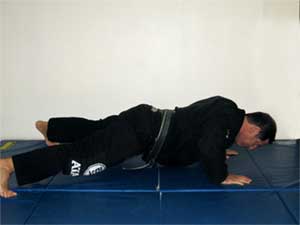 B - Bring your body close to the mat, leading with your head |
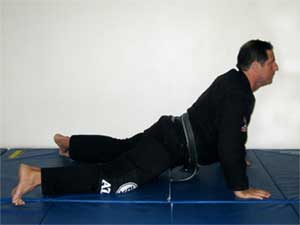 C - Finish in an upward facing arch. Return to the initial position and do 20 repetitions |
Exercise 4: Gi Rows
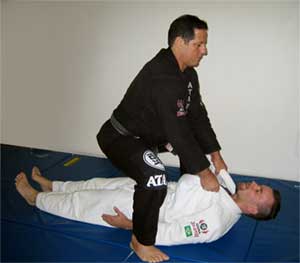 A - Marcus starts by squatting down and gripping his partner’s lapels |
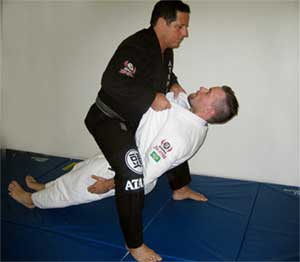 B - Maintaining a straight back he pulls his partner up to him. It is important that the man on the bottom keeps his body stiff like a board. Complete 15 repetitions, and then continue on. |
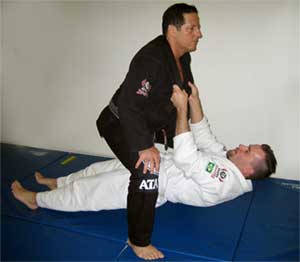 C - Switch roles. Now it is his partner’s turn: he grips Marcus’s lapels from below… |
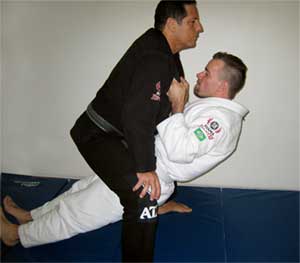 D - …and pulls himself up. Complete 15 repetitions and then the hanging partner becomes the standing partner |
Note: pullups can be substituted for this exercise if you don’t have a partner.Try starting with 2 sets of 10 pullups.
Exercise 5: Partner Squats
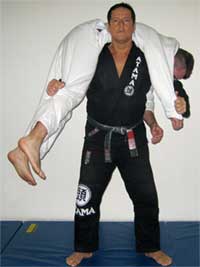 A - Marcus starts with his partner draped over his shoulders |
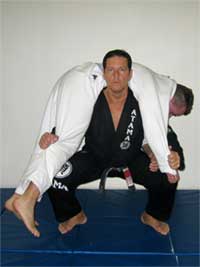 B - He does 20 squats, making sure that his knees bend at least 90 degrees each time. Change roles and repeat. |
Note: if you don’t have a partner you can substitute bodyweight squats for this exercise. Try doing 50 to 100 bodyweight squats (making sure that your thighs end up parallel to the floor at the bottom of your squat) or 5 one-legged squats per leg.
Exercise 6: Squat Walks
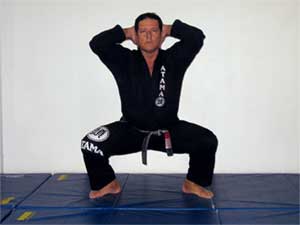 A - Marcus starts in a low squat position with his thighs parallel to the floor. |
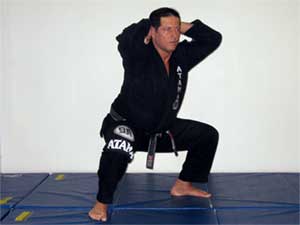 B - Staying low he steps forward with his right leg. |
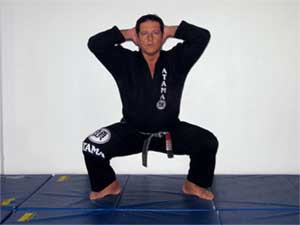 C - He then steps his right leg back to the starting position… |
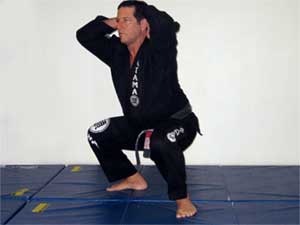 D - …and now steps forward with his left leg Continue alternating left and right for 1 minute. Stay low the entire time. |
Exercise 7: Leg Swings
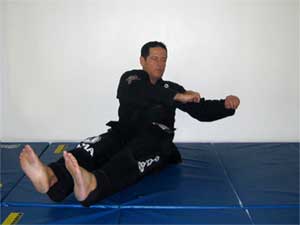 A - Sitting on his buttocks Marcus swings his legs one direction and his arms the other. |
 B - Keeping his legs off the floor he swings his legs to the other side. Alternate for 30 full repetitions |
Exercise 8: Twisting Situps
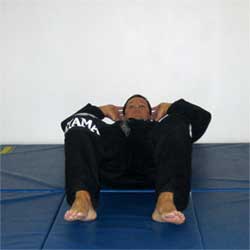 A - Marcus starts out flat on his back with his knees bent. |
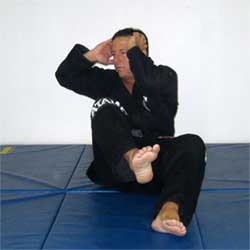 B - He sits up and touches his elbow to the opposite knee. |
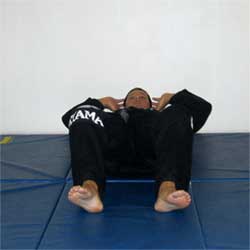 C - He goes back down. |
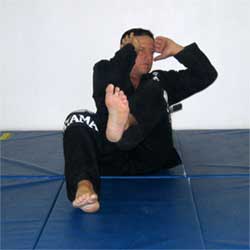 D - And repeats on the other side. Complete at least 50 repetitions |
Exercise 9: Teeter-totter Stretch
 A - Sit with your legs flat on the floor |
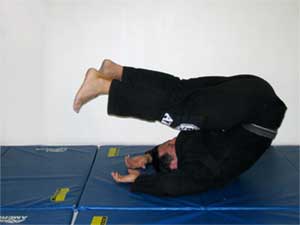 B - Roll backwards… |
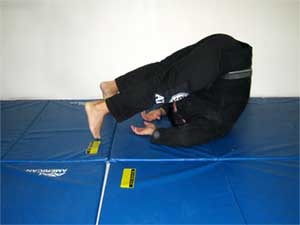 C - …until your feet touch the floor |
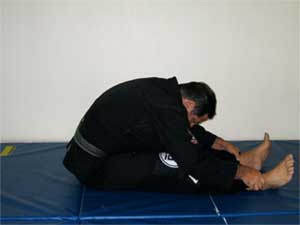 D - Now roll forward and touch your feet with your hands. Do this 15 times to cool down after your warmup. |
The post Conditioning for the BJJ Fighter appeared first on Grapplearts.
